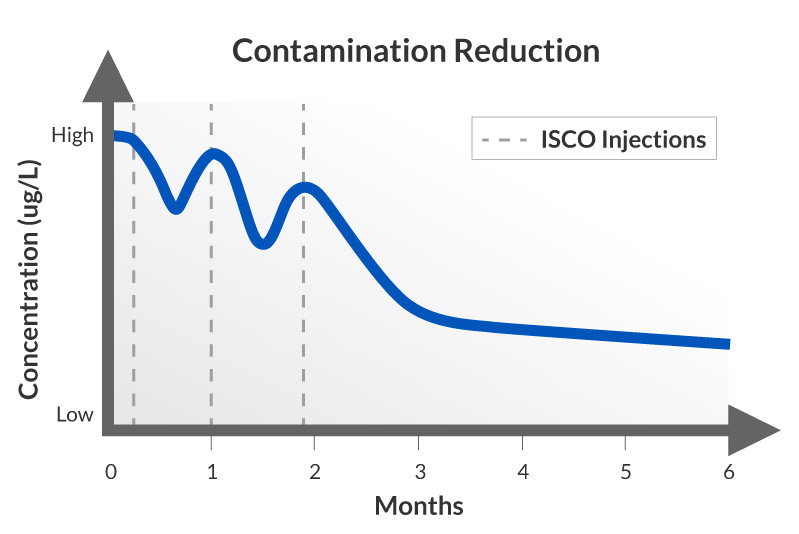In Situ Chemical Oxidation (ISCO)
At a Glance
In Situ Chemical Oxidation Overview
In Situ chemical oxidation (ISCO) involves the injection or direct mixing of reactive chemical oxidants into groundwater and soil for the primary purpose of rapid and complete contaminant destruction. ISCO is a versatile treatment technology that is most often deployed in source zones characterized by moderate to high contaminant concentrations in groundwater, significant sorbed contamination, and the potential presence of residual, separate-phase contamination (LNAPL or DNAPL droplets or ribbons).
Successful treatment of source zones requires a detailed understanding of the nature and distribution of contaminant mass as well as an aggressive application approach that will maximize oxidant-contaminant contact and deliver a sufficient amount of oxidant to treat the dissolved, sorbed, and separate-phase contaminants. REGENESIS offers two safe and effective oxidation technologies for soil and groundwater treatment – PersulfOx® and RegenOx®. Both of our ISCO technologies employ unique and powerful catalysts to maximize treatment longevity, ensure efficient oxidation, and promote safe chemical use in the field.
REGENESIS reviews data from dozens of sites each week where ISCO is being considered. Our highly experienced professionals work with our clients to develop technically rigorous and cost-effective solutions for ISCO treatment of a variety of contaminants at sites with diverse conditions. Our no-cost project evaluations typically take into account:
- Treatment goals
- Practitioner health and safety
- Nature and extent of contamination
- Soil characteristics and hydrogeology of the target treatment zone
- Potential combination with other remediation technologies (e.g., bioremediation, thermal treatment, excavation, etc.)
- Application approaches and methods
REGENESIS welcomes the opportunity to provide you and your team with the tools you need to successfully plan and execute your next ISCO project.
9 Reasons to Consider ISCO to Treat Your Site
 This ebook outlines the benefits of in situ chemical oxidation (ISCO). There are a variety of chemical oxidants that will have varying levels of effectiveness depending on the target contaminant, soil conditions, hydrogeology, and remedial goals, but if used intelligently and selectively, they can be a very budget-friendly remediation tool to achieve positive results. In situ Chemical Oxidation (ISCO) is a cost-effective technology that involves delivering chemical oxidants into the subsurface soil and groundwater to destroy organic contaminants. ISCO can be applied in a variety of ways, and is a safe and effective remediation approach. It is also applicable to a range of subsurface conditions and is scientifically proven to achieve rapid results.
This ebook outlines the benefits of in situ chemical oxidation (ISCO). There are a variety of chemical oxidants that will have varying levels of effectiveness depending on the target contaminant, soil conditions, hydrogeology, and remedial goals, but if used intelligently and selectively, they can be a very budget-friendly remediation tool to achieve positive results. In situ Chemical Oxidation (ISCO) is a cost-effective technology that involves delivering chemical oxidants into the subsurface soil and groundwater to destroy organic contaminants. ISCO can be applied in a variety of ways, and is a safe and effective remediation approach. It is also applicable to a range of subsurface conditions and is scientifically proven to achieve rapid results.
If you currently have a project and need a remediation solution now, request a design.
Have questions or want to explore some ideas? Contact Us to get in touch with a local representative.
Learn More
- Is ISCO the right solution for your contamination concern? Find out here.
- 9 Reasons to Consider In Situ Chemical Oxidation to Treat Your Site. Download eBook.
- Learn more about the right REGENESIS products for ISCO:
- Have a look at our track record with ISCO with these Case Studies.
FAQs about In Situ Chemical Oxidation
In Situ chemical oxidation (ISCO) involves the direct mixing of reactive chemical oxidants into the groundwater and soil in order to quickly eliminate contaminants within the subsurface. ISCO is a versatile treatment technology that is often deployed in source zones characterized by moderate to high contaminant concentrations in groundwater, significant sorbed contamination, and the potential presence of residual, separate-phase contamination (LNAPL or DNAPL droplets or ribbons).
In Situ Chemical Oxidation is right for your project if the source zones have moderate to high contaminant concentrations in groundwater, significant sorbed contamination, and the potential presence of residual, separate-phase contamination (LNAPL or DNAPL droplets or ribbons). Additionally, ISCO requires that you have a detailed understanding of the nature and distribution of contaminant mass as well as an aggressive application approach that will maximize oxidant-contaminant contact and deliver a sufficient amount of oxidant to treat the contaminants.
During In Situ Chemical Oxidation, the chemical reaction varies according to the oxidant amendment used, the contaminant, and the subsurface geochemistry. Many chemical oxidants have been brought in from other industry sectors and can be hazardous. Certain technologies, such as RegenOx, have been developed specifically for sensitive environmental use in aquifer restoration. RegenOx is a power, yet safe amendment, that leaves no deleterious residues behind and remain a resilient treatment with additional bioremediation techniques.

 Americas
Americas Europe
Europe Français
Français Deutsch
Deutsch Italiano
Italiano Español
Español




